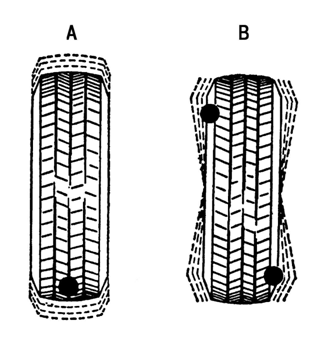All about testing
Tire unbalance and its causes
With the creation of a first car, a first wheel balance problem appeared. Over the years, the traffic speed on the roads increased, the road pavements changed, and accordingly the unbalance problem changed.
Unbalance is the presence of unbalanced rotating masses: hubs, brake drums, rims and especially tires making driving more difficult. This unbalance reduces the life of the shock absorbers, suspension, steering, tires, road safety and increases maintenance costs.
Any tire is a rotating object with a symmetrical shape, through which the center of gravity must lie on the axis of rotation, and all the points in the surface of the wheel sections should be equidistant from it.
The wheel is considered balanced when the axis of rotation is the main central axis of inertia. However, both wheels and tires are produced with certain allowable errors. From this we can conclude that any wheel is almost always asymmetric, and therefore has an unbalance.
There are two types of unbalance (see img.): static (A) and dynamic (B).
Static unbalance is an uneven distribution of mass on the rotational axis, wherein the wheel has a vertical plane. When the wheel rotates the unbalanced mass generates a centrifugal force Pc that when the wheel rotates in the direction of alternating creates a torque on the axis, which leads to the breaking of the suspension.
This unbalance is eliminated by applying a force Pc equal to the force Pc in magnitude, but opposite in direction. This is achieved by attaching additional sinker (load) at the point opposite the point of the unbalanced mass. This is called static balancing.
Dynamic unbalance occurs due to the uneven distribution of mass in the plane of the wheel. With dynamic unbalance a pair of oppositely directed forces F is applied to the wheel, acting on a specific shoulder relative to the plane of rotation. Dynamic balancing is performed on special balancing benches. Basically when balancing wheels we face the combined unbalance (combination of static and dynamic unbalances).
Sometimes, wheel unbalance may occur because of its design features, such as variable pitch tread, the presence of the vent hole in the disc, opening for brake adjustment in the brake drum or manufacturability –geometric shapes irregularities, dimensional tolerances, material inhomogeneities, etc.
The biggest influence on the wheel unbalance has a car tire. It is most distant from the rotation center, has a large weight, a complicated multi-component structure, made of different materials, rubber, textiles, steel wire etc. The farther from the center is the excess mass of tire material, the more influence on the unbalance it has.
There are several major factors influencing the unbalance of tires:
- tread joint, unevenness of the thickness along the circumference, variable pitch tread, for winter studded tires – studs (in the new tire and to the extent of their loss);
- joints in the fiber cord, joints plies in the carcass and breaker strip;
- joint of the sealing layer in a tubeless tire;
- excentricity of bead rings, a large overlap of wire in bead rings;
- impermanence of cords angles in carcass plies and breaker strip;
- discrepancy of cords in layers;
- molds manufacturing precision;
- different in thickness of the sidewalls and side strips;
- groupping of marking in one place of the tire side strip, etc.

